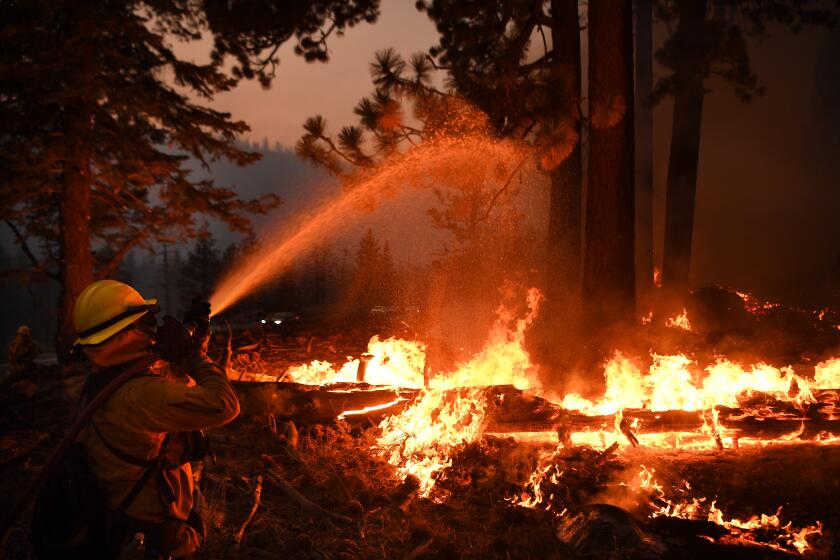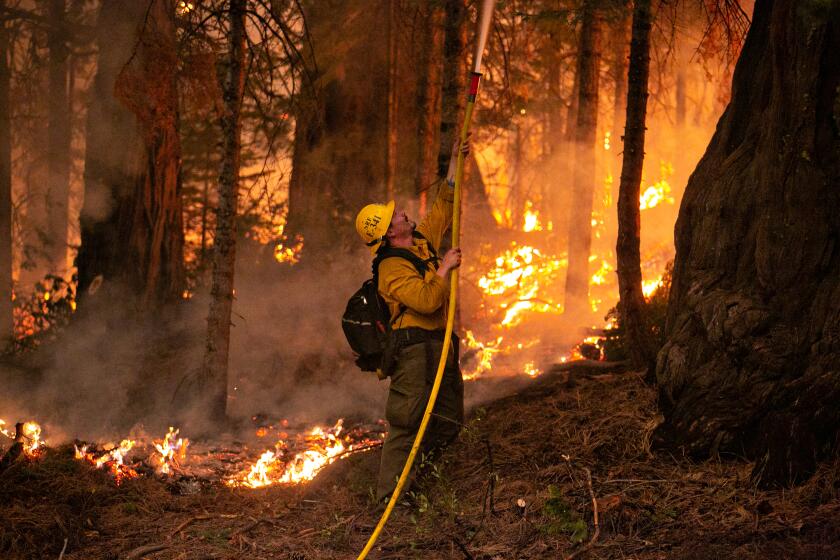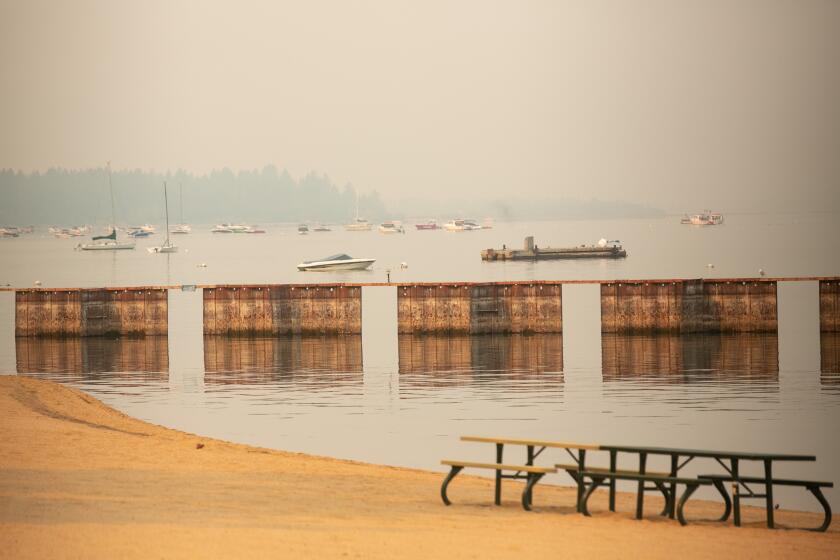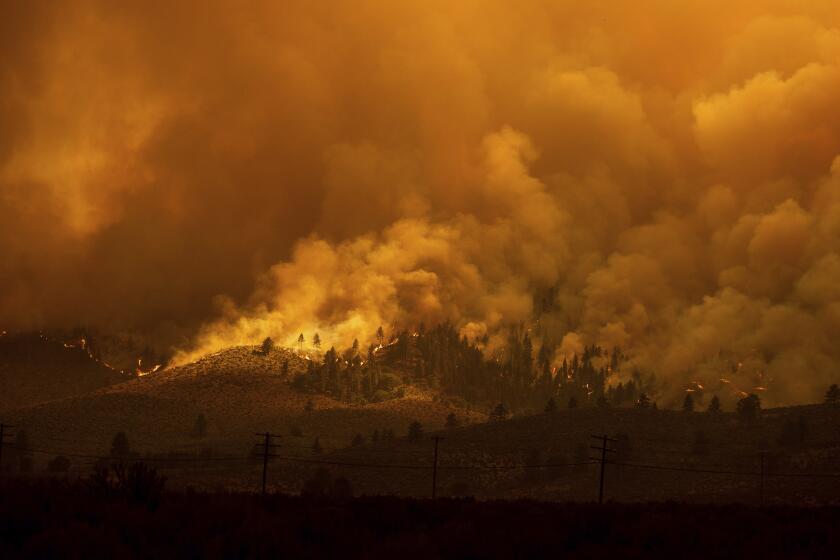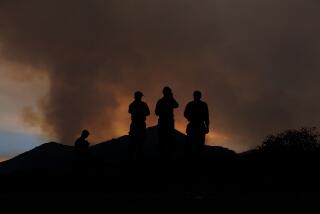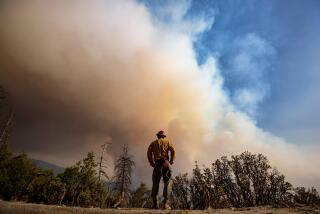Multiple California wildfires prompt evacuations, threaten homes
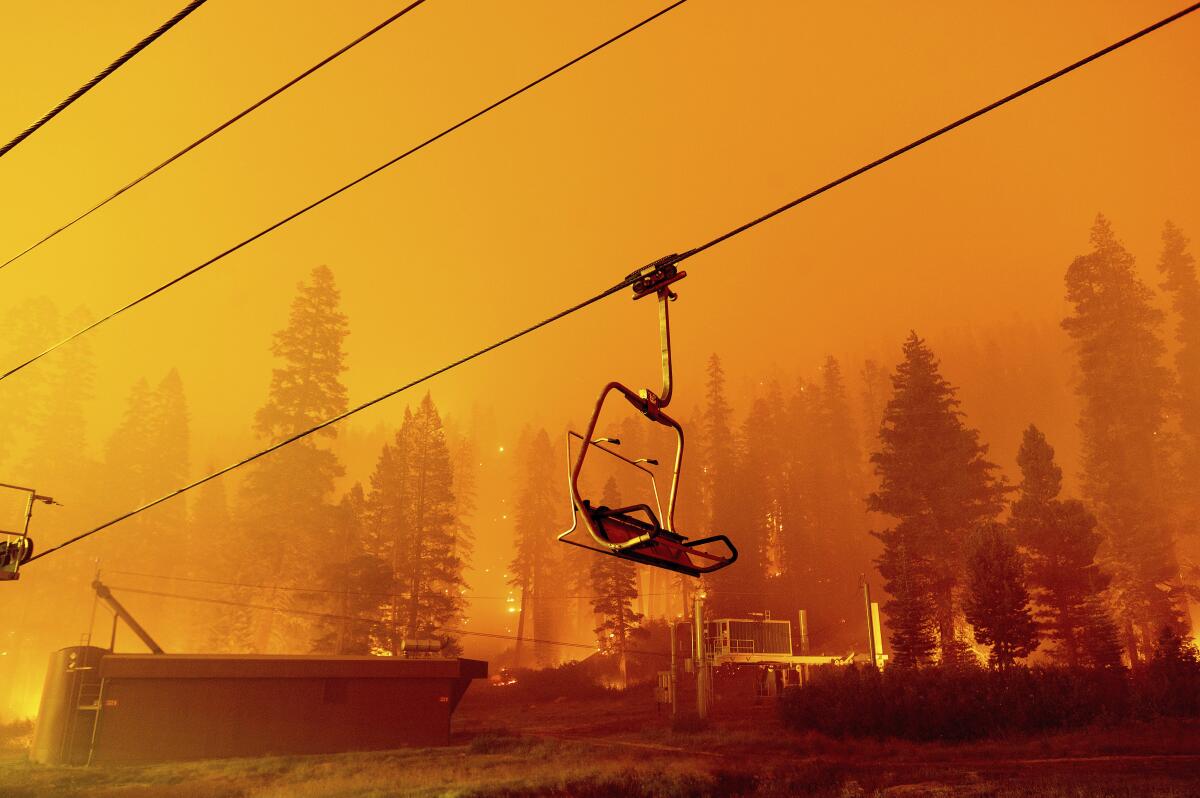
- Share via
Multiple wildfires burning across California are creating misery for the state’s residents as they spur evacuations, threaten homes and spew noxious smoke into the air.
The fight against the Caldor fire burning near South Lake Tahoe took a turn for the worse Sunday, when officials said fire activity was “more aggressive than what was anticipated.” The majority of South Lake Tahoe was placed under mandatory evacuation orders Monday.
Strong winds fueled spot fires and flareups that saw gains slip away, as containment of the 177,260-acre fire dropped from 19% on Sunday morning to 14% by Monday morning. More than 20,000 structures are threatened by the fire.
Thousands rushed to leave South Lake Tahoe as the resort city came under an evacuation order due to the Caldor fire.
Acreage and containment updates for the Caldor fire were not available from state fire officials Monday night.
“A couple of days ago I really felt we were turning a corner with it,” operations section chief Eric Schwab said Sunday, noting that the fire had been creeping eastward at a pace of about half a mile each day.
But Sunday, it “moved about 2 ½ miles on us, with no sign that it’s starting to slow down,” he said.
The biggest threat to the Tahoe Basin could be yet to come, as the National Weather Service has issued red flag warnings of gusty wind conditions.
During an emergency operations update on Monday, California Department of Forestry and Fire Protection chief Thom Porter said firefighters were starting to get some control on the west side of the fire, where the communities of Sly Park and Grizzly Flats were already heavily damaged.
But they were continuing to struggle on the east side, which is even harder to access. Conditions deteriorated Sunday, when an inversion that had been effectively keeping a lid on recent fire activity lifted, Porter said.
“When air clears, it’s like taking the lid off of your pot of boiling water,” he said. “All of the sudden there’s that plume of heat and steam that comes out. Same thing happens on a fire. It also sucks in oxygen from all directions, puts fire and spot fires in all directions. That’s what happened yesterday.”
For days, the big question has been whether the Caldor fire will jump the large granite ridge that stands between it and populous South Lake Tahoe. Many residents hoped that the stony topography would act as a buffer.
In a Monday evening update, officials confirmed the fire had moved into Christmas Valley and Meyers, a town about seven miles south of South Lake Tahoe, and said so far, no structures in that area had been damaged.
Earlier that day, authorities placed much of the area under an evacuation order — a worrisome indication that crews could be losing footing on the wind-whipped fire. Red flag warnings indicating gusty winds as strong as 35 mph have been issued across much of the fire zone.
Residents in some parts of the area closest to the fire, such as the Christmas Valley, were ordered to leave even sooner.
“The hardest part is to pack,” Carol Bin, 61, said from her driveway in the Christmas Valley this weekend. “Do I pack for a week? Or do I pack like I’m never coming back?”
As the destructive Caldor fire creeps closer to the popular resort area, the boaters, hikers and beach-goers who typically descend on South Lake Tahoe have all but vanished.
But the Caldor fire is only one of more than a dozen large fires burning in California, including some that have been churning through the landscape for weeks or even longer.
“One thing to understand is that there’s many other fires going in the state,” said Caldor fire unified incident commander Dusty Martin. “Not just in the north, but also in the southern part of the state. We’re all competing for the same resources.”
There are more than 15,000 personnel working on fires in California; the effort includes nearly 1,200 fire engines, 315 hand crews, 367 dozer units, 411 water tenders and 111 helicopters, Mark Ghilarducci, director of the California Governor’s Office of Emergency Services, said Monday.
More than 43,400 Californians have been told to evacuate, he said.
“We know these are difficult times and we continue to be all hands on deck,” he said.
The assistance includes 1,059 California National Guard soldiers, sailors and airmen who are providing support to fire suppression operations that range from space-based platforms to boots on the ground, said Maj. Gen. Dave Baldwin. Most recently, 150 military police members were sent to help El Dorado County and the California Highway Patrol conduct traffic control points and secure evacuated areas, he said.
In addition, the National Interagency Fire Center has requested that about 200 active-duty U.S. Army personnel be deployed to serve as firefighting hand crews. The soldiers were scheduled to be trained over the next week and sent to fire lines in Northern California in early September, the agency said in a news release.
On of the state’s highest priority fires, the multi-county Dixie fire burning in Northern California, has long since claimed the title of the second largest wildfire in the state’s recorded history. On Monday, the fire was 771,183 acres and 48% contained.
It, too, prompted new evacuation warnings Sunday, even as evacuation orders for other parts of the fire were reduced or lifted. Officials said crews on the Dixie fire would also contend with gusty red flag conditions through Tuesday.
“We have had some pretty strong winds today from the southwest gusting up to 27 mph,” Dixie fire meteorologist Mark Loeffelbein said Sunday. “Our relative humidity — something that tells us how much humidity is in the air — is something we watch very close on fires. That fell down to around 10% today, and I don’t think we have very much changing at least over the next 48 hours.”
The strong winds will also contribute to heavy smoke in some areas near the fire, including Susanville and Burney, officials said. Air quality in Chester will reach very unhealthy levels.
“Extreme fire behavior is expected,” Cal Fire warned Monday morning.
Cal Fire officials deemed both the Dixie and the Caldor fires critical, with Porter on Monday noting that both blazes continued to display unprecedented behavior.
He noted that before this year, no fire was known to have burned from one side of the Sierra to the other. Both the Caldor and Dixie fire have now achieved that feat.
“Two times in our history and they’re both happening this month,” Porter said. “So we need to be really cognizant that there is fire activity happening in California that we have never seen before.”
The dryness of the vegetation, primed by both long-term drought and shorter-term heat waves, is making it easy for fires to ignite and even easier for them to spread.
Evacuation orders and warnings were also in place for areas near the Chaparral fire, which ignited Saturday along the border of Riverside and San Diego counties.
That fire had grown to 1,427 acres and was 13% contained Monday morning, officials said. The blaze generated a massive fire whirl over the weekend that sent smoke and flames aloft.
At least two structures have already been damaged.
A nighttime acreage or containment update wasn’t available, but officials lifted evacuation warnings and downgraded evacuation orders to warnings for the portions of Riverside County affected by the blaze, state fire officials said.
All warnings and orders for San Diego County stayed in place, officials said.
“I can’t emphasize it enough that we are still meeting our responsibility to get fires put out at as small as possible size during initial attack and that early extended attack so we can continue to fight on these bigger fires,” Porter said.
Still, officials said, there is some concern that Southern California could start to see larger, more destructive fires as the season progresses, further straining resources already committed to the northern part of the state.
“We’re starting to see that drying trend,” said Tony Scardena, deputy regional forester for U.S. Forest Service Region 5.
Evacuations are ordered as the Caldor fire marches toward Lake Tahoe. Officials say fire dangers heightened this weekend due to winds and high temperatures.
Meanwhile, the French fire, in Kern County, and the Monument fire, in Trinity County, continued to challenge beleaguered fire crews, although firefighters were starting to gain some control. As of Monday morning, the French fire had grown to 25,264 acres and was 26% contained.
In a Monument fire update, Cal Fire officials said the state “has experienced large fire activity and will likely experience an extended fire season.”
“Fires burning in Northern California are exhibiting extreme fire growth based on critical fuel conditions,” they said. “Firefighters are experiencing conditions never seen before, such as increased rates of spread, spotting and active nighttime burning.”
As of Monday morning, the 164,746-acre Monument fire, which has been burning for 31 days, was 29% contained.
More to Read
Sign up for Essential California
The most important California stories and recommendations in your inbox every morning.
You may occasionally receive promotional content from the Los Angeles Times.
